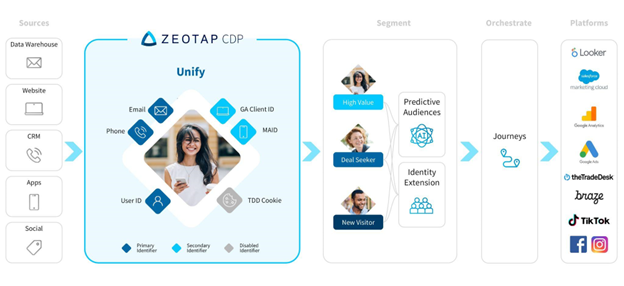Partner Content
The demand for customer data platforms (CDPs) has increased rapidly as brands adapt themselves to an increasingly digital footprint of the customer. As the CDP Institute defines it, a CDP is a “packaged software that creates a persistent, unified customer database that is accessible to other systems”.
One of the major reasons that drives the demand of CDPs is the need to unify and centralise customer data from various sources (websites, mobile apps, social media, offline channels, etc) and create a 360-degree view of their customers so that all teams in the company have the same consistent data about their customers.
Delivering personalised and relevant experiences across all touchpoints are needs that further drive the demand.
With the rise of CDPs, every large enterprise SaaS company has a CDP solution. The attractiveness of the proposition is the overall bundling with other products and ease of integration. But are there downsides to this approach? What would a company lose by being locked into an ecosystem vs investing in a platform-agnostic CDP?
What do the CDPs in the market look like?
By definition, all CDPs perform activation (if they don’t, they are not a “Real CDP”), while only some perform orchestration. Classically, CDPs are channel-agnostic and thus designed to send data to other platforms, but not necessarily orchestrate it. Traditional marketing automation tools also have a single platform view of journey orchestration, for example within the email sequences or onsite personalisation or in-App. It is now with the advanced CDPs, that marketers have the ability to do cross-platform journeys.
The traditional Customer Management solutions, like Adobe and Salesforce, have bundled the Customer Data Platform into their product suite, claiming that together they provide a comprehensive solution. However, there are different solutions in the market, such as Tealium and Zeotap, that offer a different approach to CDPs. These vendors are platform agnostic, meaning they can integrate with any technology stack, regardless of vendor or platform. In this article, we'll explore why platform agnostic CDPs are better than bundled CDPs.
Challenges of a platform-dependent CDP
The Martech landscape has exploded with the CDPs with every marketing automation, analytics and tag management product now claiming to be a CDP. But are all CDPs equal?
Here are a few limitations and challenges associated with some of the leading CDP solutions available today; that should be taken into account when choosing a CDP.
- The heritage of the CDP matters. Some have their origins in tag management, some in marketing automation/ CRM and typically provide tight coupling with those capabilities.
- CDP functions as a backbone of your Martech stack enabling dataflows and centralised coordination across all your applications. Hence, it is important for the platform to be flexible enough to work with any applications equally well and be easily extendable.
- The Martech ecosystem is continuously evolving and this implies that new capabilities are being developed every day. By being locked into an ecosystem, the company will miss out on best-of-breed capabilities being developed elsewhere in the market.
- Being locked into an ecosystem also implies considerable pricing pressures, with year-on-year escalations in the price without much ability to negotiate.
- CDP’s core functionality is being able to stitch a 360-degree view of the customer from omnichannel touchpoints, which requires powerful ID stitching capabilities for both known and unknown user scenarios. Based on the origins, CDPs are either good at creating a 360-degree view of known users and their logged-in activities or enable tracking of unknown users based on simple cookie-based solutions. However, neither is good enough in the omnichannel world, where advanced ID stitching capabilities are required for unifying customer journeys across non-logged-in, logged-in, and mobile journeys. Here is where CDPs with deep-rooted data management capabilities like Zeotap, shine above the rest.
- CDPs cater to multiple personas, and it is important for CDPs to be both simple to use for marketers as well as provide powerful data management capabilities for the IT/ Data teams for better adoption and success of the initiative.
How can a Platform-Agnostic CDP be the game changer?
A platform-agnostic CDP is one that can integrate with different marketing and customer-facing tools regardless of their underlying technology platforms. It has the right set of capabilities to integrate with various marketing and customer-facing tools, including CRMs, email marketing platforms, social media platforms, and more, regardless of the specific technologies used by these tools.
And in the most ideal scenario, it benefits its key persona - the Marketer to effortlessly use the customer data across multiple platforms and channels, without the need of any engineering assistance or being limited by compatibility issues and vendor lock-in.
Zeotap CDP can be safely defined as a platform-agnostic CDP. It transforms your siloed customer data that sits across the organisation into unified customer profiles to easily create actionable audience segments that automate and improve the personalisation of marketing, sales and customer care campaigns to drive an average of 15-35% higher efficiency.
Why choose Zeotap CDP? Here are some of its differentiators:
- Marketer-friendly UI - Its intuitive UI is designed for hands-on marketers with no need for technical coding skills
- 360 Identity - Patented and best-in-class identity stitching strategies for discriminatory digital marketing use cases
- Easy deployment - Frictionless deployment that makes existing tools and investment better with latency and cost advantages
- Personalisation at scale - Orchestrate customer journeys to deliver scalable personalisation in just a few clicks.
- Omnichannel and cross-platform activation - Activate campaigns across advertising, marketing and customer service platforms, sending data to any endpoint or API.
In conclusion, since the pace of innovation of the MarTech ecosystem is rapid, it is important to choose a customer data platform which can provide the flexibility to brands to adopt the best-of-breed technologies in the long run.

